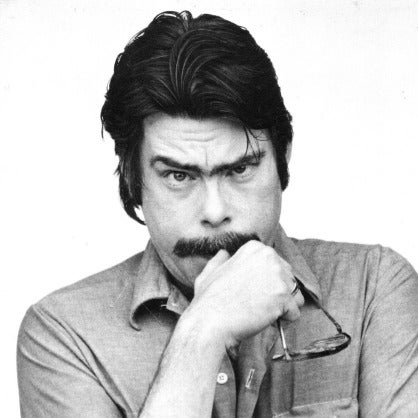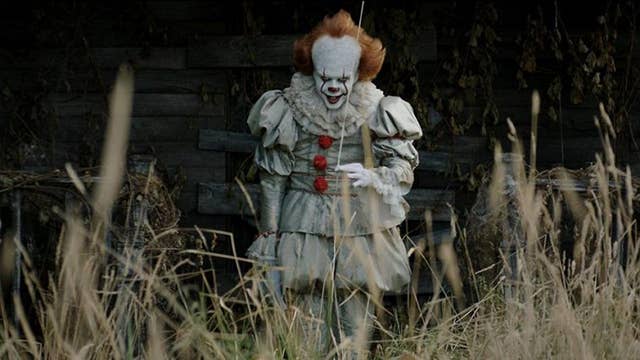
In 2012, writer/director Cary Fukunaga—who would go on to helm the riveting first season of HBO’s True Detective and Netflix’s Beasts of No Nation—got hired to adapt It. The retelling of the Stephen King’s 1986 novel parted ways with Fukunaga three years later, but his script, co-written with first-timer Chase Palmer, stuck around—partly.
The 2014 studio draft of Fukunaga and Palmer’s It screenplay is a fascinating artifact in the wake of the movie’s actual release. Now credited alongside those two is Gary Dauberman, who took another pass at the script before director Andrés Muschietti got rolling. Dauberman’s credits include Annabelle and the recently released prequel, Creation, as well as a late-stage rewrite for 2010’s A Nightmare on Elm Street remake. As he gets into gear writing It: Chapter 2, here’s a look at the improvements made and the losses suffered in the final version of It.
Ed. Note: Spoilers for the 2017 film It float down below. Continue reading at your own risk...you'll float too!
THE STUFF IT SHOULD’VE KEPT
Alternate Terrifying Encounters
Pound for pound, the It movie we received has spookier, more varied meetings between It and the Losers’ Club. That said, two Mike scenes would’ve been great to keep: one occurs in the ruins of the Kitchener Ironworks, somewhat pulled from the novel and tweaked to fold in Patrick Hockstetter’s death, and another in the Derry Home Hospital. Mike sees a sheep in a strobe-lit hallway and follows it into a morgue being flooded from the floor up. Pennywise makes a quick appearance before the horrifically mangled body of Patrick rises up from his tray, arms and legs bitten off, body covered in “child-size bite marks.” Then the walls start closing in.
Then there’s Stan’s synagogue experience. The film’s misshapen woman from the painting is great, but it could’ve come from a number of modern scary movies. The Fukunaga/Palmer script has Stan stumbling upon a mikveh pool in the basement where—unable to find the bathroom—he gets ready to take a whiz. A naked woman rises to the surface and starts making sexy-talk; we see her back is “full of sores and bleeding, her butt shredded and rotten,” with her legs “reduced to bone and gristle.”
Some Tiny Unsettling Touches
Fukunaga and Palmer planted these brief freaky moments that are particularly discomfiting for how little attention they’re given. Mrs. Kaspbrak, hunting through her purse, dumps out the contents for us to see some deflated balloons alongside the pills, tissues, and snacks. Bev’s mother (who’s not in the final version at all) eerily tells her uncomfortable daughter it’s time she, Bev, faces her imminent menstruation. “I want you to go to the pharmacy today. To be prepared. You’ll need to buy these,” Mrs. Marsh says, holding up a bloody tampon from its string.
At the library, a one-armed old man interrupts Ben’s conversation with the librarian to ask where the children’s section is. Inside the house on Neibolt Street, an old mattress is lifted to reveal a decomposing corpse of a child.
A 4th of July Firework Fight
It’s version of the book’s Apocalyptic Rockfight is highly un-apocalyptic (although radly set to the type of thrash metal one of Henry Bowers’ minions reps in T-shirt form throughout). The original script upgraded the face-off to a brutal firework fight, one where Bev fires a powerful mortar at Bowers’ car and Bowers chucks clown-face-adorned M-80’s that leave craters in asphalt. Actual lives are at stake, and Bowers’ insane vengeance is taken up another notch.
The Black Spot, and Mike’s Parents
Derry’s infestation of evil, in the book, is linked to numerous historical events, one of them being the Maine Legion of White Decency burning a local Army barracks designated for black soldiers, trapping and killing many inside (The Shining’s Dick Hallorann makes an appearance, saving Mike Hanlon’s dad). Fukunaga and Palmer slid the event up to 1960 and made it a nightclub. Mr. Hanlon tells Mike the tale while hospitalized, knowing he needs his son to understand the depth of the problem at hand. In this iteration, he and Dick end up in the city’s canal, where Pennywise floats by balloon to viciously devour other swimmers escaping the arson.
That brings up another point: Mike’s parents are actually in the original script. The It we got has Mike being raised by his grandfather; his parents died in—yup—a fire. It doesn’t serve a purpose, and robs us of a significant character in Mike’s father and a sympathetic, loving one in his mother.
The Adults’ Suffering—and Blindness
Seeing Bill’s parents grieve for Georgie in the original script—at horrible expense to their living son, and across multiple scenes—is a useful piece of the puzzle. So is the almost hypnotic adult blindness to the creature that murders Derry’s children every 27 years. Mike’s father is a great counterpoint, one of the only adults who’s willing or able to understand the nightmare. In the first few pages, his son bugs him about being home schooled and isolated from the other kids. Mr. Hanlon answers, “But you aren’t like those people. We may work with sheep, but those people are sheep. Trust me.”
A Few Fun References from Richie
It turned out full of good jokes and pop culture nods, but it would’ve been great to hear Richie suggest, on separate occasions, that the Losers’ Club send Derry’s story to both Unsolved Mysteries and Tales from the Crypt. He also speculates that Pennywise could be a twisted human rather than a supernatural beast. “You know, like the Joker in a Dark Knight comic.”
The 1879 Silver Dollar Saloon Massacre
This interlude, taken straight from the novel, simply shows a lumberjack going on an axe-murder spree in a log cabin merrymaking establishment. It might’ve been jarring both in its placement in the story and its depiction of extreme, Western-era Tarantino goriness, but the way it laces in Pennywise—as a maniacal pianist who never stops playing, no matter how much blood drenches the floorboards—would’ve been worth it.
Leaving the Sewers For Later
In Muschietti’s It, the kids hit Derry’s sewers—a.k.a. It’s home—multiple times early on. Letting the sewers’ importance be a mystery that needs to be solved, and building up to the climactic descent, is truer to the book and more dramatically satisfying.
It’s Lair
Perhaps the sharpest bit in the Fukunaga/Palmer script is It’s underground, reality-altering headquarters. The kids crawl through a claustrophobic, earthen offshoot of the sewer system to arrive in a chamber where they find themselves nightmarishly traversing “a thin membrane” that “floats over gelatinous water, very delicate, almost skin like. Beneath, thousands of spiders swim, nest and writhe.” Victor Criss, in hot pursuit, punctures the membrane and gets devoured by the supernatural arachnids.
Next comes “a massive, soaring, subterranean Pantheon-like hall,” which at the center, on the floor, has “a massive oculus, open to what appears to be the edge of infinite space.” Seven waterfalls surround it and float upward, defying gravity, to surround a crypt-like “obsidian stone heptagon-shaped structure” with an “ancient, cosmic marking.”
What transpires there, and the form in which It presents itself, we’ll stay close-lipped on, just in case it makes its way into the sequel...
THE STUFF IT WAS SMART TO CHANGE
The Intergalactic Lovecraftian Aspect
While It’s lair is cooler and more reflective of the book in the prior script, chopping this story into two distinct films—the part about the kids and the part about the adults—would’ve rushed or shortchanged this deeper exploration of the millennia-old evil. By all means, though, bring it on for the next one.
Reversing Unnecessary Changes
Fukunaga and Palmer wanted Bill Denbrough to be called Will(y), Henry Bowers to be Travis, and Patrick Hockstetter to be a Hockstettler. These are the kinds of random-ass changes adaptations make all the time for no apparent reason. The house on Neibolt Street was almost on stilts at the end of a pier on the canal. Butch Bowers’ death was course-corrected to reflect the utterly haunting way it goes down in the books—his son Henry quietly unleashing a switchblade into his neck—rather than him being stabbed dozens of times with the knife left in his eye.
Eliminating Bowers’ Racist Language
In 1980s (or ‘90s, or 2000s, or 2010s) Maine, a jerk-off bully like Henry Bowers would’ve pulled out his slur thesaurus every time he encountered Mike Hanlon. (And so it is in King’s novel, set in the ‘50s and ‘80s.) The movie intelligently ducks that easy ugly choice, which wasn’t always how it was scripted, and loses none of Bowers’ demented cruelty in the process.
Pennywise’s Voice and Dialogue
Fukunaga/Palmer’s rendition had the dancing clown showing up in the storm drain with “a perfectly pleasant and reasonable voice” that eventually “curdles into something horrible, primal even.” Bill Skarsgård’s hallucinatory performance is never so black or white, but an evolution of Tim Curry’s mush-mouthed chatter, one that’s impossible to pin down as any one style or sound. His dialogue became less cliché and more unpredictably batshit, too.
Croquet > Badminton
The old script had the Losers’ Club extracting Eddie from under his mother’s thumb by saying he had to help them break in a new badminton set. Just a teensy tiny change-up here, but in doing so, we get a subtle, unforced tie to The Shining.
Georgie’s Death
Bill Denbrough’s little brother suffers a shocking mutilation in the film, absolutely; that kid’s arm gets ripped right off, and we see him crawling away from the drain, screaming in agony and terror. But Fukunaga and Palmer had “Georgie’s rag doll body flung left and right as Pennywise feeds on him and tries to pull him through the metal grate into the sewer.” Yikes.
The Leper
C’mon, you’ve gotta have hypochondriac Eddie encountering It as a rotting leper at least once.
The Ending
It is boldly economical in its conclusion after the fatal face-off. The previous script had three scenes, none of which improved upon the final product

